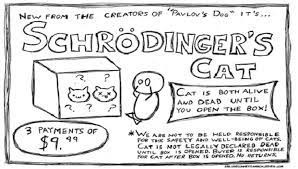
Quantum race is on
With the race to building own chips, owning the software and data that passes through, big tech is venturing into the space with speed. Why? To understand this, we should start at the very beginning. No, not at ‘the’ start of the big bang, rather the definition in which quantum computing operates. Quantum computers is known for how they handle data. Nano, small, or large sized, does not matter. The devices that we are familiar with from smartphones and laptops to the chess supercomputer store everything in bits, which is the name given to the smallest unit of information. A bit can take one of two values: 0 or 1.
Quantum computers perform calculations based on the probability of an object's state before it is measured. Consider the light bulb: It’s either on (1) or off (0). A file on a computer disk looks like a set of light bulbs, some on, the others off. Armed with many such light bulbs, you can encode information, such as the phrase “Lavina was here” or an image of the ‘universe’.
When a two-state device solves a problem, it has to turn those light bulbs on and off continuously, writing and erasing the results of intermediate calculations to prevent them from clogging up its memory. That takes time, so if the task is very complex, the computer will think for a long, long time.
Quantum computers, unlike their elder cousins, store and process data using quantum bits, or qubits for short. These can not only be turned “on” and “off” but be in a transitional state or even on and off at the same time. Continuing the light bulb analogy, a qubit is like a lamp that you turned off but continues to blink. Or like Schrödinger’s cat, which is considered simultaneously both alive and dead.
The light bulbs in a quantum computer being both on and off saves a huge amount of time. Therefore, a quantum computer can solve complex problems much faster than even the most powerful traditional device. That’s where the term “supremacy” comes in. Quantum computers in real life: We’ve established that quantum computers are pretty sharp when it comes to solving highly complex problems. Quantum technology is still young, and the state of the “blinking light bulb” is very unstable, not to mention that the more qubits a system contains, the more difficult it is to maintain stability. And the feasibility of complex calculations depends, inter alia, on the number of qubits.
Although scientists and tech giants are dipping their toes into quantum waters, for the time being quantum computers work approximately like external hard drives, connected to and controlled by regular computers. They are used to solve a narrow range of problems, such as modeling a hydrogen atom, completing the DNA mapping sequencing or searching databases. Despite quantum computing’s power, you can’t yet use it to go online and watch a video of skateboarding cool cats, or dogs in Elon’s case.
Nevertheless, many believe the future belongs to quantum computing. The first quantum computers appeared on the market back in 1999. Today, large organizations are investing heavily in this area.
However, it’s worth pointing out that the tasks solved to date has no practical use, except to demonstrate the capabilities of quantum computing. We will not delve into the nitty-gritty, because it really is very complex and not very necessary for the everyday user. If this estimate is more accurate, even non-mathematicians will spot a noticeable speed difference between quantum and traditional computers.
Quantum computers not (yet) a threat. Quantum computers are still more of a shining new toy for scientists than they are consumer devices or hacker tools. But that of course doesn’t mean that they won’t become more practical (and dangerous) down the line. Keep in mind, data security experts are already drawing up battle plans. But more about that next time. Latest glass chip is key to new quantum architecture. Reconfigurable, multicore quantum computers are goal of new IonQ chip built on "evaporated glass" and chains of ions. This new glass chip can hold 64 ions in four groups for a total of 32 usable qubits. Its computers calculate using the quantum states of ions electromagnetically trapped in the space near a chip. Previous traps were made using silicon chipmaking processes, but the company has now switched to an evaporated glass trap technology—a way of constructing micrometer-scale features in fused silica glass often used to make microfluidic chips.
Recent major breakthroughs in artificial intelligence are due to progress in the brute computing force required to process huge amounts of data rather than innovations in complex algorithms. For example: show a computer 100,000 pictures of a hotdog, and it can start to recognise and caption hotdogs in new pictures it’s never seen before. This works for computer vision, speech recognition and other pattern recognition tasks, and the effect is that machines are able to do things that they’ve never been able to do before, like sort farm cucumbers by size, shape, and colour. A definite leap for computing power, but not necessarily for superintelligence, yet. Plus, weird stuff sometimes comes out of these systems.